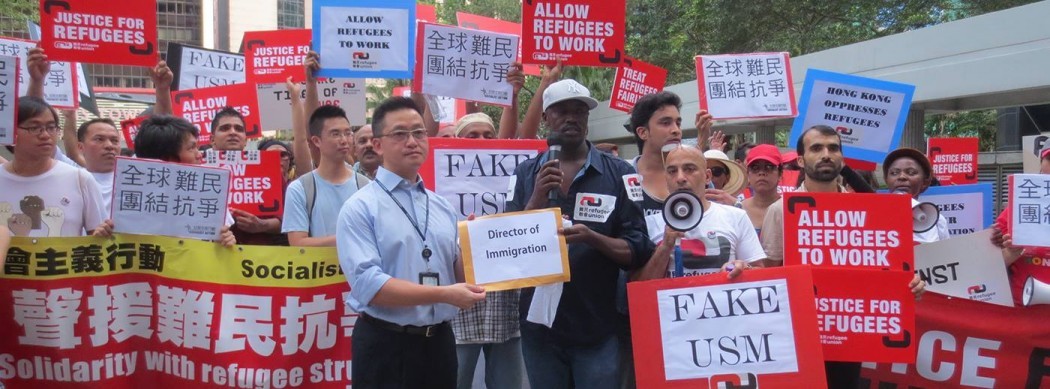By Innocent Mutanga.
Year after year, Western governments are faced with the dilemma: can they take in asylum-seekers from countries torn by war or natural disasters while protecting national interests and local security? This year has been a particularly devastating one, especially in light of the intensifying crises in Syria and other unstable countries that have displaced millions of people. Some have landed on Hong Kong’s shores, increasing asylum claims from around 6,000 last year to more than 10,000 this year. Understandably, this influx of foreigners has heightened worries among the locals. Intellectuals as well as laymen have debated the possible impact on Hong Kong’s social services, job opportunities, crime figures and population growth. In this article, I attempt to dispel myths and stereotypes that continuously fan the fears of locals, and will try to put the case for the asylum-seekers.
Where are these refugees from? The number of asylum seekers in Hong Kong is increasing; with India, Vietnam and Pakistan supplying the largest number, and a few who come from as far as Africa, like me. Actually Hong Kong has yet to see a real influx of low-wage immigrants and asylum-seekers. Still, it is Hong Kong’s duty to come up with substantial solutions both to fix its broken immigration system and to approach the refugee issue in a way that benefits both sides.

Are all the claims legitimate? I do admit that there is definitely a significant number of bogus asylum claims, from economic migrants who abuse the leniency and patience of taxpayers. In the hope of countering economic migrants, the HK government introduced a new screening system called the Unified Screening Mechanism (USM). This is rather a huge bureaucratic scam, which rewards a consistent and good storyteller over an inarticulate real asylum-seeker. Hong Kong is obliged to protect torture victims and asylum-seekers; people in both categories are classified as non-refoulement claimants, which means they must not be sent back to the country where they were at risk. If a claim is found to be substantiated, Hong Kong will comply by not sending the claimant back, but that is all that Hong Kong offers. It is left to the asylum-seeker to find a new home in a third country, and that might take six years after the non refoulement claim has been accepted. It might also take another six years for the non’refoulement claim to be processed in HK. Anyone can tell why the system is vulnerable to abuse from economic migrants; as long as it takes this long to process claims, the system will be abused.
Will asylum-seekers take our jobs? It is important to note that under the current regulations, asylum-seekers or refugees are not allowed to do paid work. One of the misconceptions people tend to have about asylum-seekers is that if given the chance, refugees will compete with locals in the workforce, thereby taking locals’ jobs. Studies have shown otherwise. Research done by Giovanni Peri of the University of California, Davis, and Mette Foged of the University of Copenhagen: “shows how an influx of lower-wage immigrants into a community tends to raise wages for everyone else.” The study examines the wages of every person in Denmark for a period of 12 years that included an influx of refugees (Peri, Foged 2014). Actually, most refugees contribute in the supply of jobs, unlike other expats who come to Hong Kong already having a job waiting for them. Hong Kong is relatively a service city, and most of the jobs need Chinese language proficiency. So most refugees, even if given a chance, cannot compete with locals. As a result, many refugees start their own small businesses in societies where they are welcome. Not all refugees can come up with groundbreaking scientific theories which will change the world, like Albert Einstein. But many refugees, whose stories have not been written, start small business, teach local kids sports (e.g cricket in Hong Kong), and bring values to the host country which help the young ones to compete in this globalized world.

Does Hong Kong have the capacity to accommodate more people? Every time I give a lecture on asylum-seekers, someone argues during Q and A that Hong Kong is too small, and has too many people already; bringing in asylum-seekers can only damage the prosperity of the city. This argument has always bothered me, knowing how strongly embedded in the hearts of many is the Malthusian ideology on population and resources. Thomas Malthus hypothesized that unchecked population growth would quickly exceed carrying capacity, leading to overpopulation and social problems, and he prophesied a lot of doom and gloom which never happened. Arguing against this notion is no different from Nicolaus Copernicus trying to convince the Catholic priests that we are not the centre of the universe. Firstly, Hong Kong’s population is not replacing itself; the average increase of population in Hong Kong is at 0.5% heading towards 0%, and this is a recipe for disaster in the long run. According to the United Nations, a developed country needs at least 2.1 children per family to maintain the population. Hong Kong has a 1.28 birth rate which would mean in a couple of decades everybody will be old, and there would not be enough people to replenish the population and labour force. Some locals are concerned about the smaller size of Hong Kong which might not sustain larger populations. This is simply an underestimation of human innovation and creativity. This is not a new concern; throughout centuries when the earth had only a million souls, there have been concerns about population, but we humans have managed to build skyscrapers,underground transportation and malls, homes on top of water, engineered crops, etc. What can stop us today from continuing our creativity and innovation in catering for our populations? Migration and population increase is an issue of the 21st century that needs 21st century solutions and ways of thinking.

How much does the government spend on asylum-seekers and refugees? Currently the Hong Kong taxpayers contribute around $600 million yearly on asylum-seekers and refugees. More than half goes to the processing of asylum claims, including the duty lawyer service. Less than half goes to everyday living expenses, which monthly per person amounts to $1, 500 rent, $300 water and electricity, $1,200 Wellcome food coupons, and $230 transportation allowance. This amount of money takes a great toll on taxpayers, and it would be unnecessary if things were approached in a more sustainable, fast and efficient way. Thank God for the good-hearted and hardworking Hong Kongers, churches like The Vine Church, and organizations like Christian Action, Crossroads, etc who spend their hard-earned income to reach out to this community with clothing, cutlery etc. However, the amount a country spends on asylum-seekers entirely depends on how it chooses to approach the problem. Australia detains its asylum seekers at huge expense. Britain takes relatively long to process claims, which means a huge toll on taxpayers’ pockets, and Hong Kong also takes too long to process asylum claims. Hong Kong may choose to look on the hypothetical downside of having more asylum-seekers, but the actual fact is that in the long run asylum-seekers have proven to be a very promising risk in the countries where they are welcome. Yes, upon receiving asylum-seekers, the city would face huge expenses, but things do change in the long run. After all, if the asylum claims were being processed faster, the taxpayers wouldn’t have to suffer such a burden.
Will more refugees lead to higher crime rates? The media representation of asylum-seekers on issues of crime tends to look very bad, but there is no substantial evidence that having more asylum-seekers increases the crime rate in a city. I would not deny that there have been instances when asylum-seekers were involved in serious crimes like rape and drug trafficking. However, most of the crimes committed by asylum-seekers are poverty crimes like stealing. Looked at objectively it is a very rational decision for someone who is given $1, 500 for rent to steal in order to top it up. How would anyone expect the asylum-seekers to pay for their rent if they can’t have income? Surprisingly, research has proven that in many American cities which welcome immigrants/asylum-seekers there has been a significant decrease in the crime rate.
Currently Hong Kong is just like every other Chinese city, though it claims to be a world city; it is probably more Chinese than Guangzhou in my opinion. Hong Kong is trying to forge a unique identity different from that of the mainland part of China. Asylum-seekers are indeed something Hong Kong has, that if leveraged well, could contribute to this new Hong Kong identity; asylum-seekers bring culture that is so rich and can turn Hong Kong into a real world city.
In the end, Hong Kong needs a form of capitalism with a human heart to be different from China’s capitalism. Hong Kong’s thriving capitalism would be no different from every form of exploitative capitalism if Hong Kong neglects the fears and dreams of those that come to its shores. When asylum-seekers flee from their countries, they leave everything behind and there is only one thing they bring to the shores of Hong Kong: dreams. If Hong Kong is to be an equal competitor in this globalized world, it needs to wake up from slumber and grab the opportunity that migration has brought to its shores. Migration replenishes the population, and asylum-seekers are the central part of migration today. Yes, when asylum-seekers come to the shores of Hong Kong, it is a burden. But if Hong Kong deals with asylum-seekers in a way that benefits both sides, in the long run, asylum-seekers can be a blessing to Hong Kong and a ‘huge profitable investment’.
